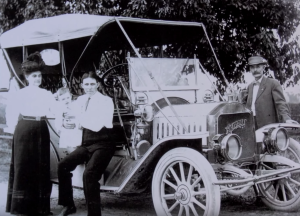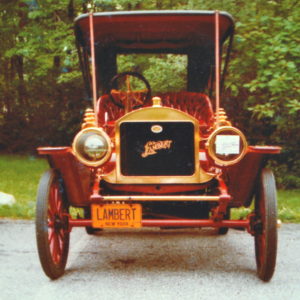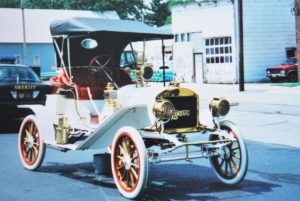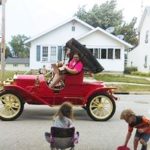Ray Lambert’s Essay on his Father’s First Car
 In 1937 my grandfather Ray Lambert wrote about his father John William Lambert’s process as John built America’s first car. Ray grew up with the car industry. He was a three-year-old toddler when his father built the sturdy, unique self-propelled buggy in Ohio City, Ohio in 1891. Ray remembered riding in it. As a young man Ray was involved with his father’s business, in sales, as an entrepreneur and at one point served as President of Lambert Automobile Manufacturing Company. This photograph is from the Anderson Herald Bulletin video of Top 50 Influential People, published August 26, 2015. I believe the younger man is my grandfather Ray. If that is true it is one of only very few images of him. I hardly knew my grandfather as he died when I was only five. In this bit of writing I have transcribed for you here, Ray goes into detail about the development of John’s engine, the first gasoline engine in America for an individual motor vehicle. That engine, in fact, is what Ray calls “something new under the sun”.
In 1937 my grandfather Ray Lambert wrote about his father John William Lambert’s process as John built America’s first car. Ray grew up with the car industry. He was a three-year-old toddler when his father built the sturdy, unique self-propelled buggy in Ohio City, Ohio in 1891. Ray remembered riding in it. As a young man Ray was involved with his father’s business, in sales, as an entrepreneur and at one point served as President of Lambert Automobile Manufacturing Company. This photograph is from the Anderson Herald Bulletin video of Top 50 Influential People, published August 26, 2015. I believe the younger man is my grandfather Ray. If that is true it is one of only very few images of him. I hardly knew my grandfather as he died when I was only five. In this bit of writing I have transcribed for you here, Ray goes into detail about the development of John’s engine, the first gasoline engine in America for an individual motor vehicle. That engine, in fact, is what Ray calls “something new under the sun”.
Here is the text in full:
Letter by A. Ray Lambert, son of John William Lambert on January 28, 1937
The story of the first gasoline automobile built in the United States has never been told. Many, many stories have been told about so-called first automobiles, but the facts and figures, together with all the data concerning actually the firth automobile, are in the hands of the writer.
May I first describe the nature of the man who built the first gasoline car in this country. He was a very busy man, and at the time of his marriage, he having had experience in the lumber business as well as in the grain elevator business, moved to what was then Enterprise, Van Wert County, Ohio, and what later became Ohio City, Ohio, located just about six miles from Van Wert.
Naturally, things of moment received things of action. Some time in 1876 his father drove to a little town about ten miles away to have some hides tanned by a tannery located in Greenville, Ohio, and on the day that he left these hides he saw an engine operating machinery in the tannery without using a boiler. He came home that night and told his son of this particular machine and said that he was to return the following Thursday to get the hides. The boy asked him if he could go along, because he wanted to see this power machine.
On the day that they returned to the tannery it was discovered that the tannery had burned down the night before, and even though things were warm, the son, in this year 1876, got everything away from around this engine and tore it to pieces to see what made it run. It was a slide valve coal gas engine, and thought but a young man at that time he had gained his first knowledge of a type of engine which did not require a boiler.
After his marriage, as above mentioned, he moved to Enterprise, or Ohio City, Ohio, and there operated the grain elevator. This was a rich farming country, and there were three railroad lines that intersected at this poi8int. He was a tireless worker, and within a short time the elevator had taken on rather large proportions. He had opened up an implement store. He owned the opera house, or the town hall, the jail, and whatever else seemed to fall within the activities of that particular town.
He had never lost sight of the idea of obtaining power from a gas engine since his first experience in 1876, and at about this time he heard about and became interested in a car that was being built in Germany by Carl Benz. Up to this time he had never built a gas engine; primarily because he had been too busy with other things perhaps to do this, but it was always on his mind.
In relating this story I am do9ng so first hand, from the papers that I hae accumulated from him, through many conversations and perhaps because of the fact that I happen to be his son, who remembers having ridden in the first automobile and who, since his very early years, has lived through the development of the automobile industry and who through his lifetime was never very far away from the industry, and who still is in the manufacturing business, producing automotive parts and machine tools especially built for the; automotive manufacturer.
It so happened that a man by the name of John R. Hicks had made application in December, 1890 for some patients on a stationary gas engine, and through Mr. hicks John W. Lambert got in touch with a Mr. Wacholtz, who was a German engineer and who had previously worked with Mr. Hicks.
On the 20th day of December, 1890 Mr. Wacholtz made a contract with John W. Lambert to go to work for him developing an automobile engine and a license arrangement had been made with Mr. Hicks whereby any of his patents could be used. This license granted to Lambert a “shop right or license to manufacture gas engines embodying the improvements invented by the said Hicks as above stated for use only on land vehicles other than railway or tramway cars.”
Mr. Lambert had no desire to build a stationary gas engine at this time. He had heard of, and had investigated to the bet of his ability, Benz’s car, and he had an incessant desire to build a horseless carriage. Gas engines in those days were extremely heavy for the horseless carriage, and the Benz car was a belt driven machine, and he felt that if he could build a motor light enough and did not depend open belts to propel it he would have something that could be utilized in this country as a transportation vehicle.
His original specifications for the engine on this machine were three cylinders, which is interesting in that it involved his conception of a balanced motor. He hired Mr. Wacholtz to work for him in his spare time for a given salary, Mr. Lambert to pay all of the expenses of building the machine, and the machine work was done at a plant then in existence in Cleveland, Ohio, by the name of the Lowell Machine Works, which was locat3d on the viaduct in 1890. They had gas in Cleveland, and that was one of the reasons for building this engine in Cleveland. He also had the body constructed in Cleveland, as well as the running gears.
When this engine was completed, using Mr. Wacholtz as a draftsman and whatever knowledge he had of gas engines at that time, Mr. Lambert gained his first experience in the design of an engine.
It is interesting here to note that his first ideas involved lightness. He went to such extremes as having a crank case enclosed by means of a case built by a manufacturer in Cleveland who took burlap and formed it as a crank case cover and treated it through some process of his own to make it oil proof and oil tight.
However, after having spent approximately $3,300.00 on the work Mr. Wacholtz was never able to make the engine run, and it was never made to run in Cleveland. This did not cover a long period of time, but as a rapid development. Mr. Lambert, originally having agreed to put up $200.00, the estimated cost for the machine work required on this machine, had but his time spent some $3,300.00. He therefore stopped work in Cleveland and shipped the machine to a small machine shop in Van Wert, Ohio, where he could give it his personal supervision and at the same time carry on his regular business.
The design of the machine involved two clutches and two chains, which were connected to a jack shaft. A single chain made the connection from the jack shaft to the rear axle. The rear wheels were locked to the axle and the bevel great type of differential was used on that machine, the two clutches giving two speeds forward, but no reverse was used. The single wheel in front was steered by means of both a foot lever and a hand lever. Since the steering was direct the foot lever could be used to rest the arms when the operator was tired of using one method or the other.
Shortly after this machine was shipped to Van Wert, Ohio, it was completed. The thing that was necessary to complete it, however, was means of carburetion.
Mr. Lambert had heard of a means of vaporizing gasoline, and made a trip to New York to see an engine built by Daimler of Germany which was operating on a boat. Of course, a great deal of secrecy surrounded all developments at this time. There are a great many lever and various mechanical movements connected with the carburetor device onto his engine, and Mr. Lambert returned to Ohio City without having done more than to find that a vapor was being made by mixing air and drawing the air up through a proportionately small amount of gasoline to create the vapor to operate the vehicle.
He then proceeded to do this in this own way, and developed what he called a “Vaporizer”, and within a few days had his machine in operation. This vaporizer was simple affair, wherein he drew the air past the gasoline, picked the gasoline up in the proper proportions, produced the vapor to go into the cylinders, and with a make and break ignition he fired the charge.
Unfortunately, in his desire to build alight machine, and without any proper materials, it is to be noted that the crank shaft was a built up crank shaft. The cheeks were made of malleable iron, while the pins were made of 1-1/4” diameter cold rolled. The connecting rods were made of malleable iron, and all the bearings were Babbitt bearings. Shortly after the engine was first started he broke the outer end of the crank shaft and so he removed one cylinder because of lack of any manufacturing or repair facilities in Van Wert, and started it a second time as a two cylinder engine, resenting his crank shaft for this purpose.
However, the crank shaft gave way on this and he had to drop back to a single cylinder engine because of the conditions outlined. Having done this, the parts wore sufficiently strong to function, and it was with no difficulty that he was able to operate the engine from then on. His father and a brother had become immensely interested in what he wading, and asked him to write them as soon as he had been able to make the engine run. He wrote them and they wired him that they would arrive in Ohio City on the midnight train.
When they did arrive he met them at the station and suggested that they go home and rest, and talk over the engine the following morning. This they would not do, for they wanted to see the engine operate that night, so he took them to the implement store and started this engine without any difficulty.
His father was somewhat skeptical, particularly about the power such a small engine night have. However, the engine in its final single cylinder form had a 3-1/2” bore and a 4” stroke. His father picked up a large elm plank and obtained a fulcrum of some sort and began to bear down on the fly wheel, his son gradually opening the throttle to produce more power.
After the father and the brother had satisfied themselves that his small engine was doing remarkable things in the way of producing power they insisted on his taking them into the p5opoositionwith with, which he agreed that night to do.
However, the engine had not yet been placed in the automobile proper but this was done within the next few days. Of course, a great deal of secrecy surrounded all this work. There perhaps was no reason for it, but is was certainly something new under the sun, and even the villagers did not know what was going on about them. After the machine was completed the window blinds were pulled down and a great many trips were made in this car on the floor of the implement house, and at night time it was driven on the highways, with many a stop for along interval before the thing started again.
The man who took the first ride in the automobile is still alive and tell his story completely.
It is interesting to note that his was a four cycle engine. Mr. Lambert had come in contact with the two cycle engine and the Sintz Gas Engine Company of Springfield, Ohio was building a two cycle stationary gas engine at about this time. He was not satisfied with the principle but believed in the multiple cylinder four cycle type, and it is also interesting to note that he started out with a three cylinder engine with a view to obtaining balance, whereas when the automobile business actually came into being a number of years later practically all the prominent manufacturers started out by using a single cylinder engine, this being the simplest form in which it could be produced. When Mr. Lambert had completed this first engine he had finished his primary course in gasoline engine experience. All stationary gas engines at this time were really not beyond the experimental stage.
He ran this car a great deal to determine what was wrong with it. He found, in the first place, that the single wheel in front was not satisfactory in any manner. The car would frequently upset, and upon this wheel in the center he finally developed a spring mounting in the hope that it would ride easier, and although he built many automobiles in the years that were to follow he never built a second car with a single wheel in front.
This car was finished early in 1891. A photograph of this car was taken in August of 1891. A glance at the photograph will tell the reader what was uppermost in the mind of Mr. Lambert in constructing this car. It primarily had to be light, and of course, even a single cylinder engine of 5-1/2” bore and 4” stroke was sufficient to drive a car of this weight.
After having worked with this car and worked with this gasoline engine Mr. Lambert decided that the day of the horseless carriage was somewhere in the future, and that he was wasting money and time by giving all of his spare moments to the idea of the horseless carriage.
Both his father and his brother encouraged him to give sufficient consideration to the stationary engine because there already was a market available for the stationary engine, and it seemed advisable that he sell all his interests in Ohio City and move to Union City where his father and his brother were already in the hardware specialty business and were manufacturing poles and shafts in a small way, so in 1892 a plant was equipped to build gasoline engine and the first of the Lambert gasoline engines was built at Union City in his new plant in the year 1892.
* * *
Insofar as this question arises as to who did build the first automobile, Mr. John w. Lambert was a close personal friend of Elwood Haynes, and Elwood Haynes claimed that he built the first automobile in 1893. It is a question in my mind whether he built it or whether Apperson built an automobile in 1892, because Apperson was more of an engineer than was Haynes.
However, when the Union automobile was produced at Union City, after the Gas Engine plant and the Pole and Shaft plant had been moved to Anderson, Indiana, Mr. Lambert because a close personal friend of Elwood Haynes, and he agreed that inasmuch as all the stock of these companies was owned within the family he had nothing to gain by claiming priority, whereas Haynes who had quite a lot of stockholders to satisfy, asked to use his date as the earliest date for the production of an automobile in this country.
Mr. Lambert, perhaps, never would have said anything about priority except for the fact that this question came up at a later date by Charles E. Duryea, who, during this early period, lived in Springfield, Massachusetts. He had a brother name Frank Duryea who seems to have been the engineer in connection with the Duryea car, because in going through the patent records from 1889 to January1899 we find that all the early patents taken out by the Duryeas were taken out by Frank Duryea in 1896-7, with a single exception where one patient was taken out by Charles E. Duryea and J. Frank Duryea on August 10, 1897. We have never found any record of Charles F. Duryea ever having built a car or ever having done any work on a car in 1890-91, and his claims to priority seem to have no foundation whatever.








Thx this help my project a lot thank you so much.
THX THX THX THX THX THX THX THX THX THX THX THX THX THX THX =) =) =) =) =) =) =) =) =)